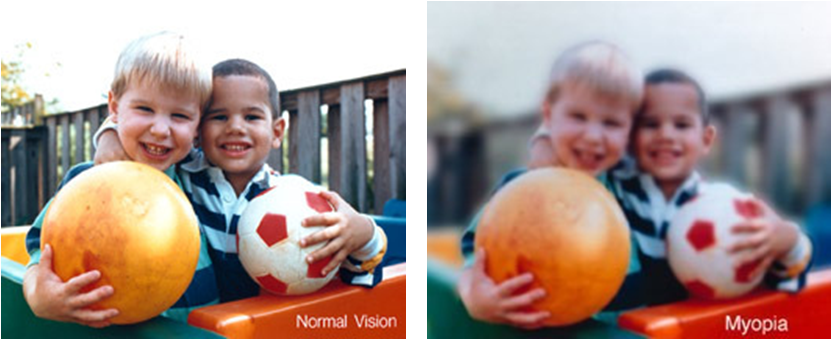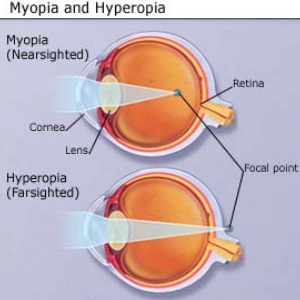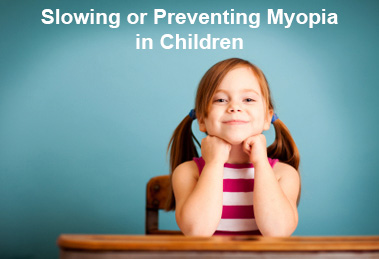Myopia or nearsightedness is the common refractive error of the eye where closer objects appear very clear, but distant objects appear blurry. This condition has become a more serious issue in recent years. Children are especially prone to this eye disorder. Usually in myopia, the objects look blurred because the light that enters the eye focusses directly in front of the retina. The prevalence of myopia has been increased from 25% to 41% during 1999-2004. An eye care specialist corrects this vision disorder through the use of corrective lenses such as glasses or contact lenses and it may also be corrected by proceeding refractive surgery. The negative diopter is the value of the corrective lens to correct the eyesight and is generally used to describe the range of the myopia i.e., negative optical power. If your child is suffering from myopia and if you’re looking ahead to slow down its progression, well we provide you the information that helps your child to reduce the risk of this eye disease.

Types of Myopia
Myopia varies from child to child depending on their clinical appearance. Usually, there are two types of myopia in children.
- Simple or Normal Myopia: It is characterized by an eye which is too long for its optical power and can be determined by the crystalline lens and cornea. Genetic and Environmental factors contribute to the development of this type of myopia.
- High Myopia: It is the severe form of the eye defect. During this condition, the eyeball stretches and becomes too long. This type of myopia may create tears or holes in the retina and even cause retinal detachment. There will be changes in vision due to the abnormal growth of blood vessels. A child with this condition needs comprehensive dilated eye exams. Early diagnosis and treatment help to prevent total vision loss.

Major Causes of Myopia
Myopia may result from certain risk factors like heredity, environment or light factors.The following are the causes of myopia in children.
- Myopia occurs when the eyeball is too large, in relative to the focusing power of the cornea and the eye lens.
- This causes light rays to focus at a certain point in front of the retina part, rather than focusing directly on its surface and results in blurred vision or visual discomfort.
- This nearsightedness can also be caused by the abnormal shape of the cornea or by the lens becoming too curved for the eyeball.
- If the child‘s parent has myopia, there will be a higher risk of getting this eye disorder.
- Exposure to daylight for long hours also causes this eye condition.
- Other reasons like more home work for children, less time spent in sports are also risk factors for myopia.
Keep Your Child’s Eyes Healthy to Reduce the Risk of Myopia
Every parent has a great concern about their child’s health, especially when it comes to eye care and protection. So as a parent, you need to protect your child from the onset of myopia and make their life happy with good vision. Start inculcating good eye care practices, even if your child doesn’t have any vision problems.
- Playing outdoors reduces the child’s risk of myopia: An Outdoor activity helps your child by delaying the development of myopia. So, support your child to spare more time for outdoor activities every day. Let them play in the playground for more time before dinner. Cycling, swimming, flying kites or playing catch are good outdoor activities for your child. Make your child well prepared before they go out for playing in the sun by applying sunscreen.
- Reduce Your Child’s Time on Unnecessary Activities: If your child likes to play computer games and mobile games, advise him or her to reduce time spent on them. Staring at a screen for too long isn’t very good for the eyes.
- Seek Eye Breaks: Computers and Books are becoming a part and parcel of a student’s life nowadays. It is recommended to take a break after every 30-40 minutes of working on the computer or reading books. Support your child to look out of the window, stretch or go out for a while to give their eyes rest.
- Healthy Lifestyle Practices: Proper nutrition and sufficient sleep are important criterions for eye health. Provide a balanced diet to your child that contains all essential nutrients and make sure that your child gets sufficient amount of sleep every night, which helps to keep your child’s eyes healthy.
If you start teaching your child well-established good eye care habits from their childhood, it leads to a right foundation that can reduce eye problems. Remember to take your child to an eye specialist for regular eye checkups. If your child has myopia, vision correction is the best way to control its effect. After proper vision correction, there will be no chance of increase in myopia for your child.
Image Credits: yedoctorguide.com, eyetalkonline.com
